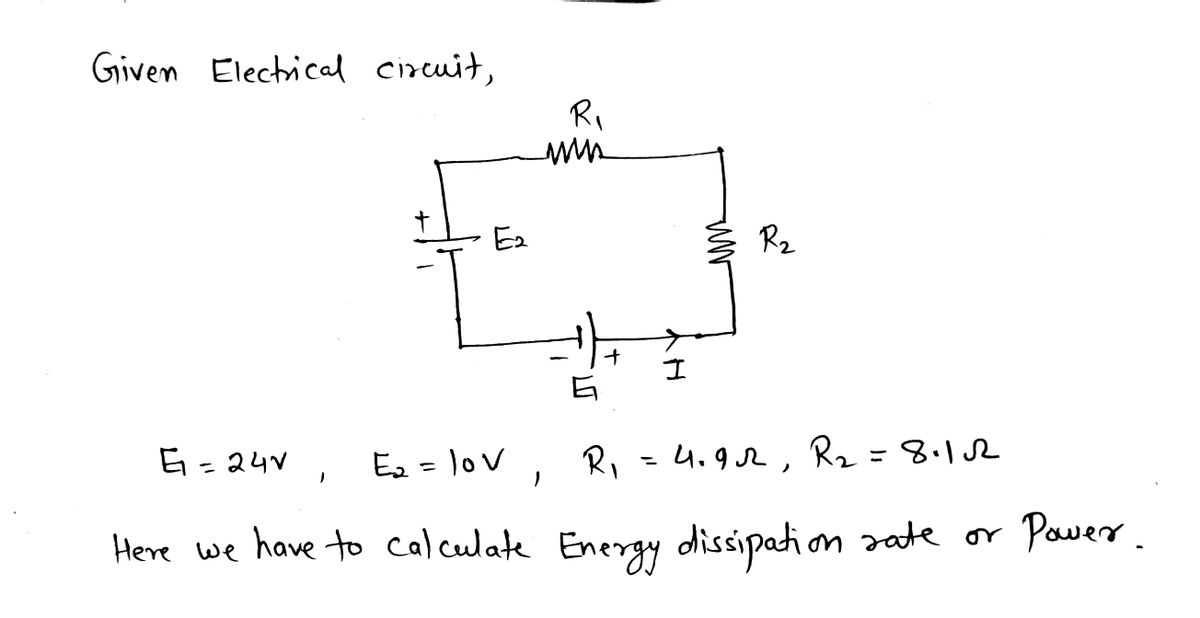In the figure the ideal batteries have emfs 81 = 24 V and 82 = 10.0 V and the resistors have resistances R1 = 4.9 Q and R, = 8.1 Q. What are (a) the current, the energy dissipation rate in (b) resistor 1 and (c) resistor 2, and the energy transfer rate in (d) battery 1 and (e) battery 2? Is energy being supplied or absorbed by (f) battery 1 and (g) battery 2? R R (a) Number i Units (b) Number i Units (c) Number Units (d) Number i Units (e) Number Units
In the figure the ideal batteries have emfs 81 = 24 V and 82 = 10.0 V and the resistors have resistances R1 = 4.9 Q and R, = 8.1 Q. What are (a) the current, the energy dissipation rate in (b) resistor 1 and (c) resistor 2, and the energy transfer rate in (d) battery 1 and (e) battery 2? Is energy being supplied or absorbed by (f) battery 1 and (g) battery 2? R R (a) Number i Units (b) Number i Units (c) Number Units (d) Number i Units (e) Number Units
College Physics
11th Edition
ISBN:9781305952300
Author:Raymond A. Serway, Chris Vuille
Publisher:Raymond A. Serway, Chris Vuille
Chapter1: Units, Trigonometry. And Vectors
Section: Chapter Questions
Problem 1CQ: Estimate the order of magnitude of the length, in meters, of each of the following; (a) a mouse, (b)...
Related questions
Question
100%
No need to answer f and g, thanks.
![In the figure, the ideal batteries have emfs \( \mathcal{E}_1 = 24 \, \text{V} \) and \( \mathcal{E}_2 = 10.0 \, \text{V} \), and the resistors have resistances \( R_1 = 4.9 \, \Omega \) and \( R_2 = 8.1 \, \Omega \).
What are:
(a) The current, the energy dissipation rate in
(b) Resistor 1 and
(c) Resistor 2, and the energy transfer rate in
(d) Battery 1 and
(e) Battery 2?
Is energy being supplied or absorbed by
(f) Battery 1 and
(g) Battery 2?
Diagram Explanation:
- The circuit diagram presented shows two batteries \( \mathcal{E}_1 \) and \( \mathcal{E}_2 \), and two resistors \( R_1 \) and \( R_2 \) forming a single closed loop.
- The positive terminal of \( \mathcal{E}_1 \) is connected to \( R_1 \), and the negative terminal is connected to \( \mathcal{E}_2 \).
- The positive terminal of \( \mathcal{E}_2 \) is connected to \( R_2 \), completing the loop back to the negative terminal of \( \mathcal{E}_1 \).
Answer Fields:
- (a) Current: [Number] [Units]
- (b) Energy dissipation rate in resistor 1: [Number] [Units]
- (c) Energy dissipation rate in resistor 2: [Number] [Units]
- (d) Energy transfer rate in battery 1: [Number] [Units]
- (e) Energy transfer rate in battery 2: [Number] [Units]](/v2/_next/image?url=https%3A%2F%2Fcontent.bartleby.com%2Fqna-images%2Fquestion%2F723329b2-1474-4be0-aa1e-d93bda3db00e%2Fe3f1be23-2f4b-44ca-ade5-30f7f3a767f5%2Fjfqai3_processed.jpeg&w=3840&q=75)
Transcribed Image Text:In the figure, the ideal batteries have emfs \( \mathcal{E}_1 = 24 \, \text{V} \) and \( \mathcal{E}_2 = 10.0 \, \text{V} \), and the resistors have resistances \( R_1 = 4.9 \, \Omega \) and \( R_2 = 8.1 \, \Omega \).
What are:
(a) The current, the energy dissipation rate in
(b) Resistor 1 and
(c) Resistor 2, and the energy transfer rate in
(d) Battery 1 and
(e) Battery 2?
Is energy being supplied or absorbed by
(f) Battery 1 and
(g) Battery 2?
Diagram Explanation:
- The circuit diagram presented shows two batteries \( \mathcal{E}_1 \) and \( \mathcal{E}_2 \), and two resistors \( R_1 \) and \( R_2 \) forming a single closed loop.
- The positive terminal of \( \mathcal{E}_1 \) is connected to \( R_1 \), and the negative terminal is connected to \( \mathcal{E}_2 \).
- The positive terminal of \( \mathcal{E}_2 \) is connected to \( R_2 \), completing the loop back to the negative terminal of \( \mathcal{E}_1 \).
Answer Fields:
- (a) Current: [Number] [Units]
- (b) Energy dissipation rate in resistor 1: [Number] [Units]
- (c) Energy dissipation rate in resistor 2: [Number] [Units]
- (d) Energy transfer rate in battery 1: [Number] [Units]
- (e) Energy transfer rate in battery 2: [Number] [Units]
Expert Solution
Step 1

Step by step
Solved in 3 steps with 3 images

Recommended textbooks for you

College Physics
Physics
ISBN:
9781305952300
Author:
Raymond A. Serway, Chris Vuille
Publisher:
Cengage Learning

University Physics (14th Edition)
Physics
ISBN:
9780133969290
Author:
Hugh D. Young, Roger A. Freedman
Publisher:
PEARSON

Introduction To Quantum Mechanics
Physics
ISBN:
9781107189638
Author:
Griffiths, David J., Schroeter, Darrell F.
Publisher:
Cambridge University Press

College Physics
Physics
ISBN:
9781305952300
Author:
Raymond A. Serway, Chris Vuille
Publisher:
Cengage Learning

University Physics (14th Edition)
Physics
ISBN:
9780133969290
Author:
Hugh D. Young, Roger A. Freedman
Publisher:
PEARSON

Introduction To Quantum Mechanics
Physics
ISBN:
9781107189638
Author:
Griffiths, David J., Schroeter, Darrell F.
Publisher:
Cambridge University Press

Physics for Scientists and Engineers
Physics
ISBN:
9781337553278
Author:
Raymond A. Serway, John W. Jewett
Publisher:
Cengage Learning

Lecture- Tutorials for Introductory Astronomy
Physics
ISBN:
9780321820464
Author:
Edward E. Prather, Tim P. Slater, Jeff P. Adams, Gina Brissenden
Publisher:
Addison-Wesley

College Physics: A Strategic Approach (4th Editio…
Physics
ISBN:
9780134609034
Author:
Randall D. Knight (Professor Emeritus), Brian Jones, Stuart Field
Publisher:
PEARSON